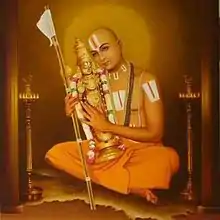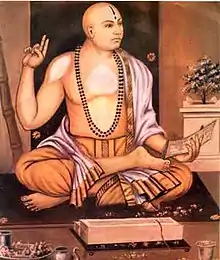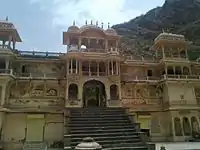Bairagi (caste)
Bairagi is a caste amongst Hindu population. It is also known by other names including Vaishnav Brahmin, or Dixit and Pujari at different places in India. They follow one of the four orders: the Visishtadvaita belief system of Ramanuja (popularized by Ramananda in North India); the Dvaitadvaita philosophy propagated by Nimbarkacharya; the Shuddhadvaita philosophy propagated by Vishnuswami (mostly popularised by Vallabhacharya in North India); or the Dvaita philosophy propagated by Madhvacharya.[1]


According to these philosophies, people are divided into four main sampradaya (religious systems):
- Shri Sampradaya[2]
- Nimbarka Sampradaya (Kumar Sampradaya)[3]
- Rudra Sampradaya[4]
- Brahma Sampradaya.
Majority of the members of the Bairagi community perform priesthood practices in temples. These people are known as:
The Bairagi community is given reservation in government jobs and educational institutes as an Other Backward Class in various regions of India. These include Chandigarh,[5] Chhattisgarh,[6] Delhi,[7] Haryana,[8] Himachal Pradesh,[9] Jharkhand,[10] Madhya Pradesh,[11] Odisha,[12] Punjab,[13] Uttar Pradesh,[14] Uttarakhand.[15]
Origin
The name Bairagi is derived from the Sanskrit word vairagya, which means, "one who is free from worldly affairs".[1]
Identification of Bairagi
A Bairagi is one whose principal deity is Vishnu or either of his great incarnations: Rama or Krishna. The caste spread throughout India, but they are more concentrated in the northwestern states of the country. Bairagis can be identified by their necklaces of Tulsi beads and their tilak, (a spot of colored powder or paste worn on the forehead, known as Urdhva Pundra). The Bairagi are vegetarian but avoid masur dal (lentil), onion, and garlic.[17]
There are 52 gotras (clans) and 52 dwaras (schools) of Vaishnavas. They follow the dual gotra system: Vaishnava Acharya gotra and Rishi gotra, i.e. Kilhadeva acharya (Kilhavat) and Kaushik gotra are gotras of the same clan. There are also some non-Brahmin Bairagis who joined the community during the Bhakti movement.[18]
Guru (spiritual guide) of Hindus
Bairāgis are the gurus (a preacher or spiritual guide) of ordinary Hindus. Most Hindu men and also women of the higher and middle castes have a guru, whose functions are, however, generally confined to whispering a sacred verse into the ear of the disciple (chela) on initiation, and paying him a visit about once a year; it is not clear what happens on these occasions, but the guru is entertained by this disciple, and a little moral exhortation may be given.[19]
Bairagi dynasties and states

Nandgaon State
The first ruler Mahant Ghasi Das of Nandgaon State, was recognized as a feudal chief by the British government in 1865 and was granted a sanad of adoption. Later the British conferred the title of raja on the ruling mahant.[21][22]
Chhuikhadan State
The chiefs of Chhuikhadan State were originally under the Bhonsles of Nagpur, the first Chief being Mahant Rup Das in 1750. However, after defeat of Marathas, they were recognized by British as feudatory chiefs in 1865 conferring the title and sanad to Mahant Laxman Das.[23]
Bairagi or Vairagi akharas
Notable people

- Tulsidas (Ramanandi - Sri Sampradaya)[25][26][27]
- Surdas (Vallabhachari Sampradaya)
- Chaitanya Mahaprabhu (propounder of Gaudiya Vaishnavism)
- Banda Bairagi[28][29](Also Known as Banda Singh Bahadur)
- Raja Mahant Digvijai Das[30][21][22] (Last ruler of Nandgaon State)
- Mahant Raja Ghasi Das[31]
- Mahant Raja Sarveshwar Das[32]
See also
References
- R.V. Russell, The Tribes and Castes of the Central Provinces of India, Vol. II.,Macmillan and Co., Limited St. Martin's Street, London. 1916, p.94
- Chandrakanta (10 December 2017). Katha Satisar. Rajkamal Prakashan Pvt Ltd.
- "निम्बार्क संप्रदाय - भारतकोश, ज्ञान का हिन्दी महासागर". Bharatdiscovery.org. Retrieved 10 December 2017.
- Rosen, Steven (10 December 1994). Vaisnavism. Motilal Banarsidass.
- "National Commission for Backward Classes". www.ncbc.nic.in. Retrieved 2020-12-28.
- "National Commission for Backward Classes". www.ncbc.nic.in. Retrieved 2020-12-28.
- "National Commission for Backward Classes". www.ncbc.nic.in. Retrieved 2020-12-28.
- "National Commission for Backward Classes". www.ncbc.nic.in. Retrieved 2020-12-28.
- "National Commission for Backward Classes". www.ncbc.nic.in. Retrieved 2020-12-28.
- "National Commission for Backward Classes". www.ncbc.nic.in. Retrieved 2020-12-28.
- "National Commission for Backward Classes". www.ncbc.nic.in. Retrieved 2020-12-28.
- "National Commission for Backward Classes". www.ncbc.nic.in. Retrieved 2020-12-28.
- "National Commission for Backward Classes". www.ncbc.nic.in. Retrieved 2020-12-28.
- "National Commission for Backward Classes". www.ncbc.nic.in. Retrieved 2020-12-28.
- "National Commission for Backward Classes". www.ncbc.nic.in. Retrieved 2020-12-28.
- Gupta, Dr R.K; Bakshi, Dr S.R. Rajsthan through the ages - Vol 4. Jaipur rulers and administrators. Sarup & sons. p. 118. ISBN 978-81-7625-841-8.
- H.A. Rose, A Glossary of the Tribes and Castes of the Punjab and North-West Frontier Province, Vol. II., Government Printing Press Lahore (1911), p.36
- H.A.Rose, A Glossary of the Tribes and Castes of the Punjab and North-West Frontier Province, Vol. II., Government Printing Press Lahore (1911), p.36
- R.V. Russell, The Tribes and Castes of the Central Provinces of India, Vol. I.,Macmillan and Co., Limited St. Martin's Street, London. 1916, p.367
- https://rajnandgaon.nic.in/history/
- Chhattisgarh ki Riyaste/Princely stastes aur Jamindariyaa. Raipur: Vaibhav Prakashan. ISBN 81-89244-96-5.
- Chhattisgarh ki Janjaatiyaa/Tribes aur Jatiyaa/Castes. Delhi: Mansi publication. ISBN 978-81-89559-32-8.
- Princely states of India: a guide to chronology and rulers by David P. Henige - 2004 - Page 48
- [South Asian Religions on Display: Religious Processions in South Asia and in the Diaspora, Knut A. Jacobsen, ISBN hardback 978-0-415-4373-3, ISBN ebook ISBN hardback 978-0-203-93059-5]
- Rambhadracharya 2008, pp. xxvi–xxix.
- Flood, Gavin D. (2003). The Blackwell Companion to Hinduism (Illustrated ed.). Hoboken, New Jersey, United States of America: Wiley-Blackwell. p. 331. ISBN 9780631215356.
- Simoons, Frederick J. (1998). Plants of life, plants of death (1st ed.). Madison, Wisconsin, United States of America: Univ of Wisconsin Press. pp. 7–40. ISBN 9780299159047.
- David N. Lorenzen, 2006, Who Invented Hinduism: Essays on Religion in History, Yoda Press, p.56.
- R.V. Russell, The Tribes and Castes of the Central Provinces of India, Vol. I.,Macmillan and Co., Limited St. Martin's Street, London. 1916, p.324
- https://rajnandgaon.nic.in/history/
- https://rajnandgaon.nic.in/history/
- https://rajnandgaon.nic.in/history/

